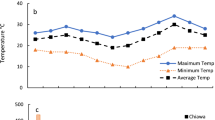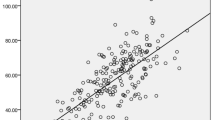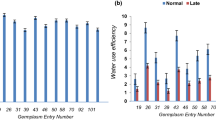Abstract
Wheat production is often limited by continual or terminal heat stress. The current study was aimed at the characterization of wild relatives and cultivated Triticum species for their heat tolerance in yield and its analysis in relation to yield components which confer yield stability at the three ploidy levels. Thirty-two non-cultivated and cultivated genotypes belonging to diploid, tetraploid and hexaploid wheat species were evaluated for heat stress tolerance in the field under full irrigation. Wheat species were sown in the field(New Delhi, India; 77°12′E, 28°40′N, 228.6 m m.s.l) at two dates of sowing, November (normal) and January (late Sowing) during winter seasons of 1994–95 and 1995–96. The late sown crop experienced 3°C warmer temperatures than that of the normal sown crop. Wide variability was observed for grain yield stability under heat stress, as the heat susceptibility index (S) ranged from 0.13 to 2.08. Hexaploidy conferred the productive and adaptive advantages as it combined high yield and stability when compared to the tetraploid and diploid groups. However within each ploidy group wide variation was observed for heat tolerance. T. aestivum cv C306 & HI1136, T. dicoccoides, T. monococcum acc. BSP1 and Ae. speltoides ssp. liqustica were highly heat tolerant in their grain yield. Stability in grain no. m- 2 conferred yield stability in all three ploidy levels, although grain weight stability also contributed to yield stability in moderately stable T. turgidum and T. sphaerococcum under heat stress. Higher biomass and grain no. m-2 are the two important traits which could be considered potential selection criteria for yield under heat stress. Of the two components of grain no. m-2, stability in spike no. m-2could be considered more important trait than grain no. spike-1. Since wide variation for heat tolerance of all the yield components are available among the wheat species, these species can be used for improving specific yield components of cultivated wheat.
Similar content being viewed by others
References
Aggarwal, P.K. & S.K. Sinha, 1987. Performance of wheat and triticale varieties in a variable soil water environment. IV. Yield components and their association with grain yield. Field Crops Res 17: 45–53.
Aslam, M., A. Majid, P.R. Hobbs, N.I. Hashim & D. Byerlee, 1989. Wheat in the rice-wheat cropping system of the Punjab: A Synthesis of On-farm Research Results 1984–1989. PARC/CIMMYT paper No. 89–3. CIMMYT, Mexico.
Bansal, K.C. & S.K. Sinha, 1991. Assessment of drought resistance in 20 accessions of Triticum aestivum and related species. I. Total dry matter and grain yiield stability. Euphytica 56: 7–14.
Berry, J. & O. Bjorkman, 1980. Photosynthetic response and adaptations to temperature in higher plants. Ann Rev Plant Physiol 31: 491–532.
Bhardwaj, R.B.L., B.C. Wright, S.S. Gill, N.K. Jain, K.C. Sharma & B.A. Krantz, 1975. The agronomy of dwarf wheats. Ind Council Agric Res, New Delhi, India, p. 94.
Blum, A., 1986. The effect of heat stress on wheat leaf and spike photosynthesis. J Exp Bot 37: 111–118.
Bruckner, P.L. & R.C. Frohberg, 1987. Stress tolerance and adaptation in spring wheat. Crop Sci 27: 31–36.
Chinoy, J.J., 1947. Correlation between yield of wheat and temperature during ripening of grain. Nature 159: 442–444.
Ciaffi, M., B. Margiotta, G. Colaprico, E. De Stefanis, D. Sgrulletta & D. Lafiandra, 1995. Effect of high temperatures during grain filling on the amount of insoluble proteins in durum wheat. J Genet Breed 49: 285–296.
Conroy, J.P., S. Seneweera, A.S. Basra, G. Rogers & B. Nissen-Wooller, 1994. Influence of rising atmospheric CO2 concentrations and temperature on growth, yield and grain quality of cearal crops. Aust J Plant Physiol 21: 741–758.
Cox, T.S., 1998. Deepening the wheat gene pool. J Crop Prod 1: 1–25.
Ehdaie, B. & J.G. Waines, 1992. Heat resistance in wild Triticum and Aegilops. J Genet Breed 46: 221–228.
Ehdaie, B., J.G. Waines & A.E. Hall, 1988. Differential responses of landrace and improved spring wheat genotypes to stress environment. Crop Sci 28: 838–842.
Fedak, G., 1985. Alien species as sources of physiological traits for wheat improvement. Euphytica 34: 673–680.
Fischer, R.A., 1979. Growth and water-limitation to dryland wheat yield in Australia: a physiological frame work. J Agric Res 29: 89–91.
Fischer, R.A. & D.R. Byerlee, 1991. Trends of wheat production in the warmer areas: major issues and economic conciderations. In: D.A. Saunders (Ed), Wheat for Nontraditional, Warm Areas, pp. 3–27. CIMMYT, Mexico, DF.
Fischer, R.A. & R. Maurer, 1978. Drought resistance in spring wheat cultivars. I. Grain yield response. Aust J Agic Res 29: 897–907.
Fischer, R.A., 1985. Number of kernels in wheat crops and the influence of solar radiation and temperature. J Agric Sci Camb 105: 447–461.
Frank, A.B. & A. Bauer, 1997. Temperature effects prior to double ridge on apex development and phyllochron in spring barley. Crop Sci 37: 1527–1531.
Gavuzzi, P., G. Delogu, G. Boggini, N.D. Fonzo & B. Borghi, 1993. Indentification of bread wheat, and barley cultivars adopted to dry areas of southern Italy. Euphytica 68: 131–145.
Howard, A., 1924. Crop Production in India: A Critical Survey of its Problems. Oxford University Press.
Hu, H. & S. Rajaram, 1994. Differential responses of bread wheat characters to high temperature. Euphytica 72: 197–203.
Jenner, C.F., 1994. Starch synthesis in the kernel of wheat under high temperature conditions. Aust J Plant Physiol 21: 791–806.
aKuroyanagi, T. & G.M. Paulsen, 1985. Mode of high temperature injury to wheat II. Comparisons of wheat and rice with and without inflorescence. Physiol Plant 65: 203–208.
Mashiringwani, N.A. & M.A. Schweppenhauser, 1992. Phenotypic characters associated with yield adaptation of wheat to a range of temperature conditions. Field Crops Res 29: 69–77.
Morgunov, A., 1994. Bread wheat breeding for heat tolerance. In: S. Rajaram & G.P. Hettel (Eds), Wheat Breeding at CIMMYT: Commemorating 50 years of Research in Mexico for Global Wheat Improvement, Chapter 3, pp. 29–35. Ciudad Obregon, Sonora, Mexico, 21–25 March.
Motzo, R., F. Giunta & M. Deidda, 1996. Relationships between grain filling parameters, fertility, earliness and grain protein of duram wheat in a mediterranean environment. Field Crops Res 47: 129–142.
Rawson, H.M. & A.K. Bagga, 1979. Influence of temperature betwen floral initiation and flag leaf emergence on grain number in wheat. Aust J Plant Physiol 6: 391–400.
Rawson, H.M., 1986. High temperature tolerant wheat: a description of variation and a search for some limitations for productivity. Field Crops Res 14: 197–212.
Reynolds, M.P., M. Balota, M.I.B. Delgado, I. Amani & R.A. Fischer, 1992. Physiological and morphological traits associated with spring wheat yield under hot, irrigated conditions. Aust J Plant Physiol 21: 717–730.
Shpiler, L. & A. Blum, 1986. Differential reactions of wheat cultivars to hot environments. Euphytica 35: 483–492.
Shpiler, L. & A. Blum, 1991. Heat tolerance for yield and its components in different wheat cultivars. Euphytica 51: 257–263.
Stone, P.J. & M.E. Nicolas, 1994. Wheat cultivars vary widerly in their responses of grain yield and quality to short periods of postanthesis heat stess. Aust J Plant Physiol 21: 887–900.
Stone, P.J. & M.E. Nicholas, 1998. The effect of duration of heat stress during grain filling on two varieties, differing in heat tolerance: grain growth and fractional protein accumulation. Aust J Plant Physiol 25: 13–20.
Tashiro, T. & I.F. Wardlaw, 1990. The effect of high temperature at different stages of ripening on grain set, grain weight and grain dimensions in the semi-dwarf wheat ‘banks’. Ann Bot 65: 51–61.
Villareal, R.L., 1994. Expanding the genetic base of CIMMYT bread wheat germplasm. In: S. Rajaram & G.P. Hettel (Eds), Wheat Breeding at CIMMYT: Commemorating 50 Years of Research in Mexico for Global Wheat Improvement, Chapter 3, pp. 16–21. Ciudad Obregon, Sonora, Mexico, 21–25 March.
Waines, J.G., 1994. High temperature stress in wild and spring wheats. Aust J Plant Physiol 21: 705–715.
Warrington, I.J., R.L. Dunstone & L.M. Green, 1977. Temperature effects at three development stages on the yield of the wheat ear. Aust J Agric Res 28: 11–27.
Author information
Authors and Affiliations
Rights and permissions
About this article
Cite this article
Khanna-Chopra, R., Viswanathan, C. Evaluation of heat stress tolerance in irrigated environment of T. aestivum and related species. I. Stability in yield and yield components. Euphytica 106, 169–180 (1999). https://doi.org/10.1023/A:1003531722420
Issue Date:
DOI: https://doi.org/10.1023/A:1003531722420




